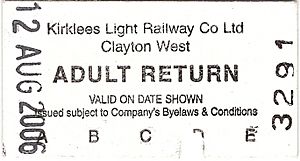Kirklees Light Railway facts for kids
Quick facts for kids Kirklees Light Railway |
|
|---|---|

Both 0-6-2ST Badger and 2-4-2 Katie rest, side by side, at Shelley station
|
|
| Locale | West Yorkshire, England |
| Terminus | Clayton West |
| Coordinates | 53°35′49″N 1°36′43″W / 53.597°N 1.612°W |
| Commercial operations | |
| Name | Lancashire and Yorkshire Railway Clayton West branch |
| Built by | Lancashire and Yorkshire Railway |
| Original gauge | 4 ft 8 1⁄2 in (1,435 mm) standard gauge |
| Preserved operations | |
| Length | 3+1⁄2 miles (5.6 km) |
| Preserved gauge | 15 in (381 mm) |
| Commercial history | |
| Opened | 1 September 1879 |
| Closed | 24 January 1983 |
| Preservation history | |
| 19 October 1991 | opened |
| 26 December 1992 | extended to Skelmanthorpe |
| May 1997 | extended to Shelley Woodhouse |
The Kirklees Light Railway (KLR) is a fun, small railway in West Yorkshire, England. It's about 3+1⁄2-mile (5.6 km) long and uses a special narrow track called a 15 in (381 mm) gauge. This means the tracks are much closer together than on a regular train line.
The KLR first opened on October 19, 1991. It runs along the path of an old train line that used to belong to the Lancashire and Yorkshire Railway. This old line once connected the village of Clayton West to other places. Today, the KLR takes you on a journey from Clayton West, through Skelmanthorpe, all the way to Shelley Woodhouse.
Contents
Journey Through Time: The KLR's History
The original train line, built by the Lancashire and Yorkshire Railway, opened on September 1, 1879. It was designed to be big enough for two tracks, just in case they wanted to make it longer later. However, only one track was ever built, and the line always ended at Clayton West.
Changes and Closures
This railway line was important for carrying coal from local mines. This helped it stay open even when many other train lines were closed in the 1960s (a time known as the "Beeching cuts"). Sadly, passenger trains stopped running on January 24, 1983. The line was completely taken apart by 1986.
Building a New Adventure
But the story didn't end there! In 1990, work began to build a new, smaller railway on the same path. This new railway, the Kirklees Light Railway, was officially approved in September 1991. Building it was easier because they could use old materials from the nearby coal mines that were closing down.
The KLR first opened with a 1 mile (1.6 km) long track, running from Clayton West to a stop called Cuckoos Nest. This name was inspired by another old small railway. The KLR was later made longer, reaching Skelmanthorpe in 1992 and then Shelley in 1996/97.
Amazing Views Along the Way
As you ride the KLR, you'll see some cool sights! You'll get great views of the tall Emley Moor transmitting station. The train also passes through Blacker Wood, an ancient forest mentioned in the famous Domesday Book. Plus, you'll go through the 511 yards (467 m) long Shelley Woodhouse Tunnel. It's the longest tunnel on any 15 in (381 mm) gauge railway in Britain!
Festive Fun: Christmas Celebrations
Every December, the Kirklees Light Railway hosts a special event called the Santa Special. Families, especially those with young children, love to ride the train. During the journey, Santa Claus himself comes aboard to give presents to the children. It's a magical way to celebrate the holidays!
Stops Along the Line: KLR Stations
Here are the stations you'll find on the Kirklees Light Railway:
- Clayton West - This is where the KLR's main office is located.
- Cuckoos Nest halt - A special stop built for the new railway.
- Skelmanthorpe
- Shelley Woodhouse - This is the end of the line for the KLR.
Meet the Trains: KLR Locomotives
All the trains used on the Kirklees Light Railway were built by the railway's founder, Brian Taylor. He used special techniques to make them run better, be more reliable, and use less fuel.
Steam Locomotives
These are like smaller versions of the classic steam trains you might imagine. They use steam to power their wheels!
| Name | Design | Type | Date Built | Fun Facts |
|---|---|---|---|---|
| Fox | Hunslet | 2-6-2T | 1987 | Fox recently had a big update that took 5 years! It's based on a train built for India. |
| Badger | Kerr Stuart | 0-6-4ST | 1991 | This train has a unique design, inspired by older "Tattoo Class" engines. |
| Hawk | Kitson Meyer | 0-4-0+0-4-0T | 1998 | Hawk is often used on weekends and for special events. It's based on a train from Chile! |
| Owl | Avonside Engine Company/Heisler locomotive | 0-4-0+0-4-0TG | 2000 | Owl also runs on weekends and for special events. |
| Katie | Guest Engineering | 2-4-2 | 1954 | This is one of the newer engines to join the KLR family. |
| Sian | Guest Engineering | 2-4-2 | 1963 | Sian is the sister engine to Katie. |
Diesel Locomotive
- 0-4-0DH Jay was built in 1992. It was first made with an engine from an old train at Blackpool Pleasure Beach. Jay was rebuilt in 2002 and again in 2008 with newer engines. It's probably the busiest engine on the line, often moving other trains around, and sometimes even pulling passenger trains!
Petrol Locomotives
- No 7 The Tram was built in 1991. This unique train started as a small trolley for workers. Later, it was given a body that looks like an old steam tram. It's mainly used for special events, like "Day out with Thomas" days, giving rides to children.
Gallery









